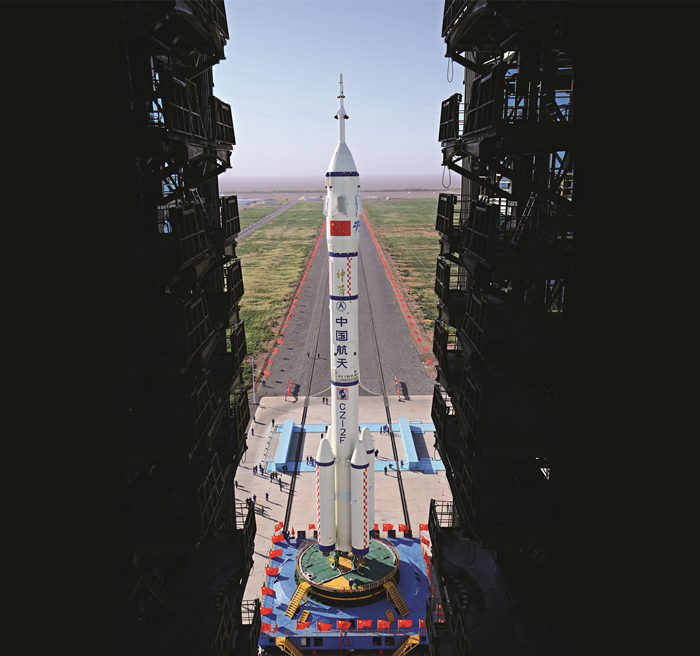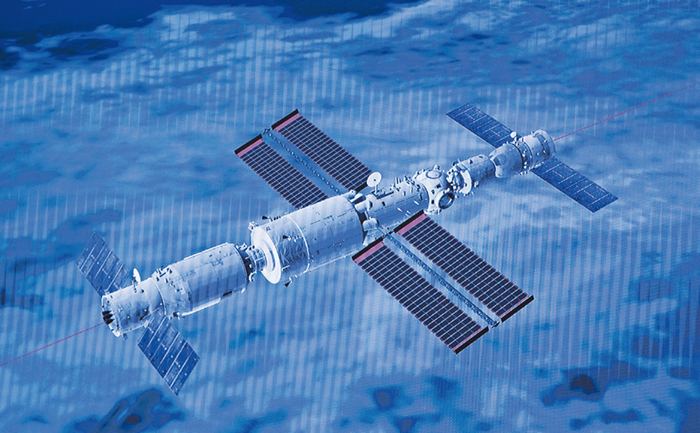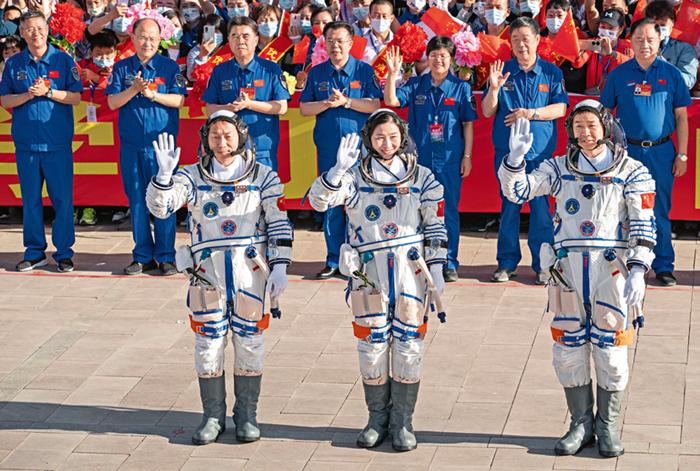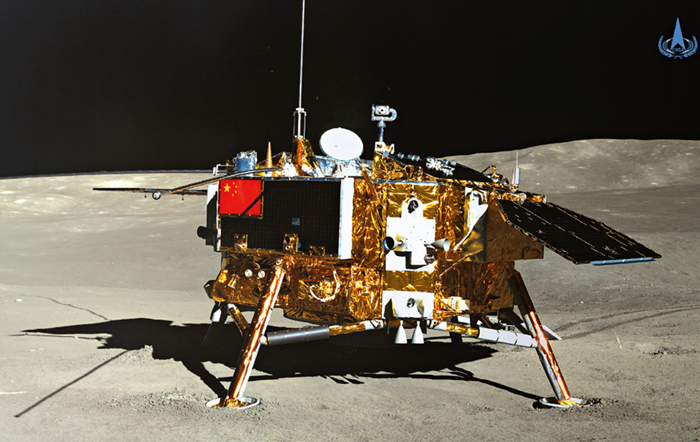|
||||||||||
| Home Nation World Business Opinion Lifestyle ChinAfrica Multimedia Columnists Documents Special Reports |
|
||||||||||
| Home Nation World Business Opinion Lifestyle ChinAfrica Multimedia Columnists Documents Special Reports |
| ChinAfrica |
| Epic Space Voyage |
| Persistent endeavors and continuous breakthroughs put China in pole position in space exploration |
| By Xia Yuanyuan 丨VOL. 14 JULY 2022 ·2022-07-07 |

Combination of Shenzhou-14 manned spacecraft and Long March-2F carrier rocket has been transferred to launch pad in Jiuquan Satellite Launch Center on May 29 (XINHUA)
Taikonaut Liu Yang, who made history 10 years ago by becoming China’s first woman in space, began her second journey into the space aboard Shenzhou-14 spacecraft on the morning of June 5, when a Long March-2F rocket carrying the spacecraft lifted off from the Jiuquan Satellite Launch Center in northwest China’s Gansu Province.
Watching the launch on TV some 1,800 km away at their home in Zhengzhou, capital of Henan Province in central China, Liu’s parents were elated. It was a proud moment for any parent.
Her father, 72-year-old Liu Shilin, said he felt “relieved, excited and proud.” Compared to her first mission 10 years ago, they were less anxious this time around. The peace of mind also stemmed from the advances China has made in manned space technology in the past decade.
“The last 10 years can be seen as the transitional decade of China’s aerospace,” Yang Yuguang, Vice Chair of the Space Transportation Committee of the International Astronautical Federation, said. Ten years ago, China’s aerospace industry followed other aerospace powers in the world in most fields. With the continuous development of aerospace technology, China is already “running side by side” with others, or even taking the lead in some fields.
Liu will stay in space for six months, working together with her two colleagues Chen Dong and Cai Xuzhe, to complete the construction of China’s space station.

Screen image captured at Beijing Aerospace Control Center in Beijing, capital of China, on June 17, 2021 shows China’s Shenzhou-12 manned spaceship having successfully docked with the space station core module Tianhe (XINHUA)
Remarkable breakthroughs
The Chinese people’s romantic pursuit of space started in early times. In Chinese mythology, Chang’e was a beautiful young girl who took an immortality pill and then flew to the moon, where she became the goddess of the moon and lived in Guang Han Gong palace together with her pet Yutu, also known as Jade Rabbit. The story shows how deeply ancient Chinese people were interested in outer space.
At present, an encounter with the moon is no longer limited to imagination, thanks to the advances in science and technology. Named after the mythological character, the Chang’e Lunar Exploration Project has helped the nation take a big step toward turning its space dream into reality.
The three-step project, which began in 2004, includes orbiting and landing on the moon, and bringing back samples. On October 24, 2007, China began its journey to the outer space with the successful launch of Chang’e-1. The lunar orbiter entered the moon’s orbit 12 days later.
Since 2012, the lunar exploration project has made continuous innovations and breakthroughs. On December 14, 2013, the Chang’e-3 landed on the moon, marking the first landing of a China spacecraft on the surface of an extraterrestrial body, carrying a lander and a rover called Yutu. The probe acquired a geological profile of the moon, and discovered a new kind of lunar rock. In 2016, the landing site of Chang’e-3 was named Guang Han Gong, or Moon Palace, and was approved by the International Astronomical Union.
On January 3, 2019, the Chang’e-4 probe made the first-ever soft-landing on the Von Karman Crater in the South Pole-Aitken Basin on the far side of the moon. In December 2020, Chang’e-5, one of the most complex and challenging missions undertaken in China’s aerospace history, retrieved about 1,731 grams of samples from the moon. It was also the world’s first moon-sample mission in more than 40 years.
The success of the Chang’e-5 mission marked the conclusion of China’s three-step lunar exploration program. In his congratulatory message to the mission, Chinese President Xi Jinping, who is also General Secretary of the Central Committee of the Communist Party of China, said that it marks a great step forward in China’s space industry, and will contribute to deepening the understanding of the origin of the moon and the evolution of the solar system.
But the moon is not the only target of China’s space exploration program. In July 2020, the launch of Tianwen-1 aboard a Long March-5 rocket, marked the beginning of the country’s planetary exploration of the solar system. The spacecraft consisted of a rover called Zhurong, and an unnamed orbiter. Zhurong touched down on Mars on May 15, 2021.
Zhurong is tasked with surveying Mars’ landforms, geological structures, soil characteristics, potential locations of water and ice, and atmospheric and environmental features, as well as magnetic, gravitational and other physical fields. The 1.85-meter-tall, 240-kg robot has traveled nearly 2,000 meters and has obtained a great deal of scientific data by now. It’s a key step in China’s current Mars exploration program aiming to combine orbiting, landing and roving in one mission.
“This fully demonstrates the wisdom of Chinese space scientists and shows that China has entered the world’s advanced ranks in the field of planetary exploration,” said Zhang Kejian, Head of the China National Space Administration.
Manned missions are a major feat in China’s space endeavor. In October 2003, the country launched its first manned spacecraft Shenzhou-5, carrying its first taikonaut Yang Liwei. In June 2021, three Shenzhou-12 taikonauts - Tang Hongbo, Nie Haisheng and Liu Boming – entered the Tianhe core module of China’s space station. The three Shenzhou-13 taikonauts - Zhai Zhigang, Wang Yaping and Ye Guangfu - returned to Earth in April this year after spending six months in the space station module, the longest stay in space by taikonauts during a single mission.
Liu Yang and the other two taikonauts of Shenzhou-14 mission successfully entered the core module on June 5. During their six-month stay, the crew will witness the completion of Tiangong space station, the “home in space” for the Chinese people, and will welcome the Shenzhou-15 crew aboard the space station before departing for Earth, which will be the space station’s first crew handover.
Powering these manned missions are carrier rockets, the backbone of all space activities. In the past decade, the China-developed Long March carrier rocket series boasted world-class launch success rate. According to Long Lehao, Academician of the Chinese Academy of Engineering and senior advisor for the development of the Long March carrier rocket series at the China Academy of Launch Vehicle Technology, the Long March carrier rocket series carried out 92.1 percent of China’s space launch missions between 1970 and 2021, sending more than 700 spacecraft into space, with a launch success rate of 96.25 percent.
Tiangong’s core module, Chang’e-5 lunar probe, Tianwen-1 Mars probe, Shenzhou manned spacecraft, Tianzhou cargo craft, BeiDou-3 navigation satellites, and multiple space vehicles were all sent into the space by Long March rockets. They have been playing a big part in scientific exploration and people’s livelihood.
Wang Xiaojun, Head of the China Academy of Launch Vehicle Technology, said that the new-generation manned carrier rockets and heavy-lift carrier rockets that are under development will power China’s key space projects, including the fourth phase of the lunar exploration project, the exploration of asteroids and Jupiter, manned lunar missions, and the first Mars sampling mission, among others.

Crew members of the Shenzhou-14 mission, Chen Dong (right), Liu Yang (center) and Cai Xuzhe, attend a preflight ceremony at the Jiuquan Satellite Launch Center in Gansu Province on June 5 (XINHUA)
Down to Earth
On a 1,334-hectare flat contiguous farmland of Agricultural Reclamation Qianjin Farm in Ningxia Hui Autonomous Region, dozens of large agricultural machines are crushing soil, turning the ground and laying pipes.
Unlike traditional farms that rely on manual intensive farming, the farm machinery here relies on the BeiDou autonomous driving system to allow the farm to operate around the clock, effectively improving the efficiency of agricultural production.
Behind this efficient management of agriculture is a breakthrough in China’s satellite navigation system technology. After decades of planning and construction, China now possesses one of the world’s major navigation satellite systems - the BeiDou Navigation Satellite System (BDS).
China started to explore a navigation satellite system suited to its national conditions in the 1980s, laying down a three-step strategy. The BDS-1 project, the first step, got official approval in 1994, when China was still facing an international technology blockade, and domestic component manufacturers were at a nascent stage. The second step was to construct the BDS-2 system, which started in 2004. It is the world’s first hybrid constellation, in which satellites in three kinds of orbits work in concert. In June 2021, the final satellite to complete the BeiDou-3 network lifted atop a Long March-3B carrier rocket.
“Users can get the high-precision services of the BDS anywhere in the world,” said Yang Changfeng, BeiDou’s chief architect. At the end of 2018, BeiDou began providing positioning, navigation, timing and messaging services worldwide. At present, the BeiDou global location service platform is offering high-precision services in more than 20 countries around the world, with a total of over 2 billion users.
China has more than 500 satellites in orbit. In addition to satellite navigation, breakthroughs have also been made in communication and remote sensing technologies in recent years.
For example, the three Gaofen-3 satellites are designed to work in tandem to obtain reliable high-resolution synthetic aperture radar images and provide operational data support for China’s marine development, terrestrial environmental resource monitoring and disaster prevention and mitigation. The Fengyun series meteorological satellites have been providing accurate weather forecast services.
On June 2, a Long March-2C carrier rocket carrying a group of nine commercial satellites blasted off from the Xichang Satellite Launch Center in southwest China’s Sichuan Province. Owned by GeeSpace, a subsidiary of Geely Technology Group, the satellite system will be mainly used to research and validate technologies such as driving assistance for intelligent connected vehicles and vehicle-mobile phone interaction.
Thanks to the favorable industrial policies, firms like GeeSpace are mushrooming in China. According to business information portal Qichacha, 95,000 space-related enterprises have been established in China so far. More than 10,000 space-related companies were registered annually from 2017 to 2021.
“Most of China’s private aerospace companies were established after 2015. Despite a short period, they have been catching up quickly in terms of technology,” Liu Baiqi, Founder and CEO of Galactic Energy, a Beijing-based space technology startup, told ChinAfrica.

Photo taken by the rover Yutu-2 on January 11, 2019 shows the lander of the Chang’e-4 probe (XINHUA)
Open mind for cooperation
The Entoto Space Observatory Facility sits at an altitude of 3,200 meters on the hill of Entoto, about 20 km north of Ethiopia’s capital Addis Ababa. In the command and control center, technicians are recording the data sent back by Ethiopia’s first satellite - ETRSS-1 - in real time.
In December 2019, the East African country launched its first-ever satellite into space from China. The ground station of the 72-kg multispectral remote sensing satellite is located in the Entoto space facility.
The sensing satellite is expected to monitor the environment and weather patterns for better agricultural planning, early warning for drought, mining activities and forestry management of the country.
Yilkal Eshete, Project Manager for Satellite and Ground Systems Development of the Ethiopian Space Science and Geospatial Institute, still remembers working with Chinese partners.
“During the satellite development process, more than 20 Ethiopian engineers and scientists received training in satellite technology, ground applications, and satellite maneuvering from China,” Eshete told ChinAfrica. After the satellite was launched and entered into orbit, Ethiopian engineers could independently run ground operations and application systems.
Eshete said China’s achievements in aerospace reflect extraordinary human endeavors in the area of space exploration. “China has strengthened the space technology capacity building in the developing countries, and laid a solid foundation for their independent space development,” he said.
China believes that the scope for space exploration is infinite. Peaceful exploration and use of outer space is a common cause for all human beings, a cause that should lead to greater welfare for all.
Based on the principle of equality and mutual benefit, peaceful utilization and win-win situation, China has actively cooperated with the world in lunar exploration, Mars exploration, satellite projects and launch services to promote the common progress and long-term sustainable development of the space industry.
China has launched an International Lunar Research Station project with Russia and has signed cooperation agreements with the BRICS (Brazil, Russia, India, China, and South Africa) for its Remote Sensing Satellite Constellation. Over the past five years, data from China’s Gaofen-1 and Gaofen-6 remote sensing satellites have been provided free of charge to 158 countries or regions. In November 2021, Zhurong and the European Space Agency’s Mars Express spacecraft performed an in-orbit relay communication test. The China-France Oceanographic Satellite and the China-Italy Electromagnetic Monitoring Experiment Satellite are just a few of the collaborative projects now underway.
In the field of space station construction, as early as 2019, the China Manned Space Engineering Office and the United Nations Office for Outer Space Affairs jointly announced that nine projects from 17 countries and 23 entities have been included in the first batch of selected projects for the Chinese space station science experiment.
Simonetta Di Pippo, Former Director of the United Nations Office for Outer Space Affairs, said that China’s opening up of its space station is an important part of the UN’s “Access to Space for All” initiative and a great example.
According to a white paper titled China’s Space Program: A 2021 Perspective published by the State Council Information Office of China on January 28, China has signed 46 space cooperation agreements or memoranda of understanding with 19 countries and regions and four international organizations since 2016. It has actively promoted global governance of outer space, and carried out international cooperation in space science, technology and application through bilateral and multilateral mechanisms. These measures have yielded positive results.
Looking forward, information from the China National Space Administration shows China plans to carry out 60 space flights by the end of the year, complete the construction of its space station, launch research and studies for its Phase-4 lunar explorations, and finish the key technology work for major missions such as an asteroid probe and a Mars sampling and return mission.
Four space launch bases currently in operation in China
Jiuquan Satellite Launch Center, Gansu Province, founded in 1958. The launch center is mainly used to send satellites into lower and medium orbits with large orbital inclination. It is also capable of testing medium- and long-range missiles.
Taiyuan Satellite Launch Center, Shanxi Province, founded in March 1966. The launch center is capable of launching satellites into both medium and low orbits.
Xichang Satellite Launch Center, Sichuan Province, founded in 1970. Xichang has two launch pads: one for the launch of geostationary communications satellites and meteorological satellites by Long March CZ-3 rockets and the other for the lift-off of Long March CZ-2 strap-on launch vehicle and the Long March CZ-3 series rockets.
Wenchang Satellite Launch Center, Hainan Province, founded in 2009. Wenchang Satellite Launch Center’s low-latitude coastal location reduces launch fuel consumption through the centrifugal phenomenon generated by inertia, solves the transportation problem of the giant rockets through ocean shipping and offers improved security with regard to the fall of debris.
SOURCE: XINHUA NEWS AGENCY
Duration of China’s Manned Space Missions
Shenzhou-5, 21 hours, 2003
Shenzhou-6, 115 hours, 2005
Shenzhou-7, 68 hours, 2008
Shenzhou-9, 303 hours, 2012
Shenzhou-10, 350 hours, 2013
Shenzhou-11, 33 days, 2016
Shenzhou-12, 92 days, 2021
Shenzhou-13, 183 days, 2021
Shenzhou-14, 6 months, 2022
China’s Space Industry: A CHRONOLOGY
June 16, 2012:
The manned Shenzhou-9 spacecraft blasted off and made a successful automated docking with the Tiangong-1 space station two days later.
December 27, 2012:
BeiDou Navigation Satellite System started providing regional services for users in the Asia-Pacific region.
December 14, 2013:
Chang’e-3 landed on the moon, becoming the first Chinese spacecraft to softland on the surface of an extraterrestrial body.
January 11-12, 2014:
With the lunar day starting again at the Chang’e-3 landing site, Yutu lunar rover woke up on January 11, and the lander on January 12. Both vehicles depend on solar panels in order to function and do their scientific tasks.
December 17, 2015:
China’s Dark Matter Particle Explorer, nicknamed Wukong or Monkey King, was sent into space.
August 16, 2016:
China launched its first quantum experiment science satellite called Micius, or Mozi, which was the world’s first quantum science satellite.
January 3, 2019:
The Chang’e-4 probe made the first-ever soft landing on the Von Karman Crater in the South Pole-Aitken Basin on the far side of the moon, and sent back the first-ever close-up photograph of the moon’s far side with the assistance of the relay satellite Queqiao, opening a new chapter in lunar exploration.
July 23, 2020:
China launched Tianwen-1, taking the first step in its planetary exploration of the solar system.
July 31, 2020:
The completion and opening ceremony of the BeiDou-3 Navigation Satellite System was held in Beijing, and the deployment of the Beidou-3 global constellation was fully completed.
December 17, 2020:
The return capsule of China’s Chang’e-5 probe touched down on Earth, marking a successful conclusion of China’s current threestep lunar exploration program of orbiting, landing, and bringing back samples.
April 29, 2021:
China sent into space the core module of its space station.
May 22, 2021:
China’s first Mars rover Zhurong drove down from its landing platform on the Martian surface, leaving the country’s first footprints on the red planet.
June 17, 2021:
China successfully launched Shenzhou-12 manned space station mission. The three taikonauts began their six-month mission on China’s first permanent space station.
February 27, 2022:
China launched a Long March-8 rocket to place 22 satellites in space, setting a domestic record for the highest number of satellites launch by a single rocket.
April 16, 2022:
Three taikonauts of the Shenzhou-13 manned spaceship completed their six-month space station mission and returned to Earth safely. The mission completed the verification of key technologies of the space station.
June 5, 2022:
China launched the crewed spaceship Shenzhou-14, sending taikonauts Chen Dong, Liu Yang and Cai Xuzhe to its space station.
SOURCE: CHINA AEROSPACE SCIENCE AND TECHNOLOGY CORPORATION
| About Us | Contact Us | Advertise with Us | Subscribe |
| Copyright Beijing Review All rights reserved 京ICP备08005356号-5 京公网安备110102005860号 |